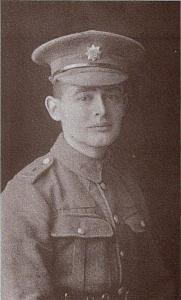
|

|
| Private Hugh Grier MERTENS (495707) | |
|
14 Platoon, D Company, 2/12th (County of London) Battalion (The Rangers) Date of birth: 17th November 1881 Date of death: 9th August 1918 Killed in action aged 36 Buried at Beacon Cemetery Sailly-Laurette Plot III Row I Grave 5 |

|
| Hugh Grier Mertens was born at Ardingly College on the 17th of November 1881 the seventh son of the Reverend Frederick de Mounteney Mertens, Head Master of Ardingly College and Vicar of Arlington, and Gertrude (nee Pennell) Mertens of "Whitmore", Cuckfield in Sussex. He was educated at Lancing College where he was in School House from September 1895 to July 1901. He was a member of the 2nd Cricket XI in 1899 and the 2nd XI Football from 1899 to 1901. He was a the Shakespearian Society and, of the Cricket XI in 1900 and 1901. He was a Corporal of the Cadet Corps in 1900 and a Sergeant in 1901. He was a member of the Committee of the Lancing College Magazine in 1900 and 1901. Of his cricket the school magazine wrote in August 1900:- "A very promising bat who has shown great improvement since the commencement of the season. Has fielded brilliantly at point and saved a lot of runs. A fair change bowler. Should be useful next year." The Lancing Magazine wrote the following on his football in March 1901:- "Centre Half--Plays a very good game, feeding his forwards well. Quite up to the 1st XI form, but is handicapped by his size." He was appointed as a Prefect in 1899 and as Captain of School in 1900. On leaving school he worked as a 3rd Class clerk for the Newcastle Branch of the Bank of England. He enlisted into the army at Brighton in the 1/8th (County of London) Battalion (Post Office Rifles) and landed in France on the 8th of February 1918 where he was attached to the 1/13th (County of London) Battalion (Kensington). In April 1918 he was evacuated to the rear suffering from an ulcerated heel and rheumatism and returned to the base depot on the 29th of June. On his return to the front he was transferred to the 2/12th Battalion of his regiment on the 13th of July 1918. On the night of the 8th of August 1918 the 2/12th (County of London) Battalion (The Rangers) moved into the front line at Morlancourt in preparation for an attack the next morning. They deployed there with D and B Companies in the front line with A and C Companies in support. Final orders for the attack were received at 4.30am with zero hour set at 5.30am. At 5.38am the battalion moved forward to the attack in good order and was immediately subjected to an enemy artillery barrage which they passed through and then came under heavy machine gun fire. In spite of having no support on their flanks the battalion took their objective and captured some two hundred and fifty enemy prisoners. Casualties for the attack were two officers killed with five wounded and ten other ranks killed with one hundred and forty six wounded. His mother applied for his medals in August 1920. He is commemorated on the war memorial tablet in Holy Trinity Church at Cuckfield in Sussex, on the memorial at the Bank of England and on a memorial cross in the churchyard facing the South Downs. He is also commemorated on the memorial at St Matthew's Church, Elswick, Newcastle-upon-Tyne and on the memorial at the Newcastle Branch of the Bank of England. |
|
| School House |
Back